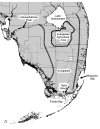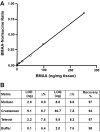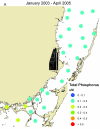Cyanobacterial Blooms and the Occurrence of the neurotoxin beta-N-methylamino-L-alanine (BMAA) in South Florida Aquatic Food Webs
- PMID: 21057660
- PMCID: PMC2968748
- DOI: 10.1016/j.hal.2010.05.002
Cyanobacterial Blooms and the Occurrence of the neurotoxin beta-N-methylamino-L-alanine (BMAA) in South Florida Aquatic Food Webs
Abstract
Recent studies demonstrate that most cyanobacteria produce the neurotoxin beta-N-methylamino-L-alanine (BMAA) and that it can biomagnify in at least one terrestrial food chain. BMAA has been implicated as a significant environmental risk in the development of neurodegenerative diseases such as Alzheimer's disease, Parkinson's disease, and Amyotrophic Lateral Sclerosis (ALS). We examined several blooms of cyanobacteria in South Florida, and the BMAA content of resident animals, including species used as human food. A wide range of BMAA concentrations were found, ranging from below assay detection limits to approximately 7000 μg/g, a concentration associated with a potential long-term human health hazard.
Figures





















References
-
- Allen CN, Omelchenko I, Ross SM, Spencer P. The neurotoxin beta-N-methylamino-L-alanine (BMAA) interacts with the strychnine-insensitive glycine modulatory site of the N-methyl-D-aspartate receptor. Neuropharm. 1995;34:651–658. - PubMed
-
- Anderson DM, Glibert PM, Burkholder JM. Harmful algal blooms and eutrophication: nutrient sources, composition, and consequences. Estuaries. 2002;25:704–726.
-
- Arnot JA, Gobas FAPC. A review of bioconcentration factor (BCF) and bioaccumulation factor (BAF) assessments for organic chemicals in aquatic organisms. Env. Rev. 2006;14:257–297.
-
- Banack SA, Cox PA. Biomagnification of cycad neurotoxins in flying foxes. Neurol. 2003;61:387–389. - PubMed
Grants and funding
LinkOut - more resources
Full Text Sources
Other Literature Sources
Miscellaneous

